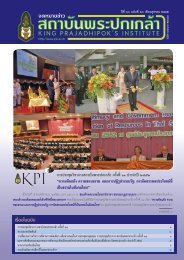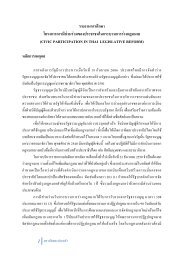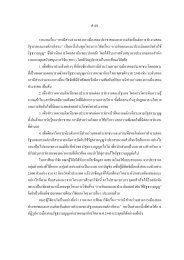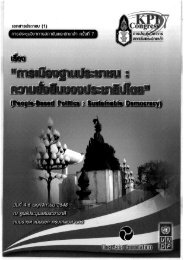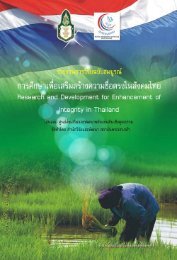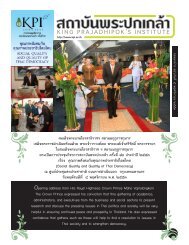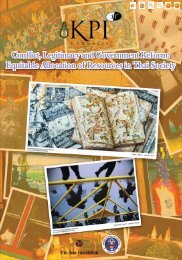SUFFiciENcy EcONOMy ANd GRASSROOtS DEvElOPMENt
SUFFiciENcy EcONOMy ANd GRASSROOtS DEvElOPMENt
SUFFiciENcy EcONOMy ANd GRASSROOtS DEvElOPMENt
You also want an ePaper? Increase the reach of your titles
YUMPU automatically turns print PDFs into web optimized ePapers that Google loves.
The Meaning of Sufficiency Economy <br />
International Conference<br />
179<br />
Strengthening Sufficiency: <br />
Interdependent Selves Within Community Economies<br />
<br />
<br />
<br />
<br />
This paper considers what makes Sufficiency Economy (SE) different from<br />
other development alternatives, notably those that stress sustainability and<br />
empowerment of communities. In particular, it compares SE to the Sustainable<br />
Livelihood Approach (SLA), a framework put forth by the British Department for<br />
International Development (DFID) in the late 1990s, when the SE model was<br />
similarly being formalized in Thailand. Both share common ground as holistic,<br />
people-centered development approaches that focus on sustainable livelihoods,<br />
though differences emerge due to their analytical versus philosophical<br />
characteristics. Both could also be improved in terms of community empowerment,<br />
best accomplished by a philosophical/ontological shift to interdependent selves and<br />
a practical/social shift to community economies. With its Buddhist nature and<br />
consideration of networks, SE is well positioned to make these shifts.<br />
<br />
Sufficiency Economy versus the Sustainable<br />
Livelihoods Approach<br />
In refining SE for application in the development field, particularly in rural<br />
development, it is instructive to compare it to a similar approach: SLA, which<br />
originated in Britain’s DFID but is now used worldwide by development<br />
organizations large and small. For those not familiar with SLA, it’s based on the<br />
ideas of development practitioners Robert Chambers and Gordon Conway (1992),<br />
who conceive of livelihoods as comprising people, their capabilities (what a person<br />
is capable of doing and being), and their means of living (including food, income,<br />
and assets). Chambers and Conway’s goals for developing livelihoods include<br />
enhancing capabilities, improving equity (equal distribution of assets, capabilities,<br />
and opportunities), and increasing sustainability. According to DFID’s guidance<br />
sheets, livelihoods are sustainable when they can recover from stress and shock, are<br />
not dependent on external support, maintain the long-term productivity of natural<br />
resources, and do not compromise the livelihoods of others. DFID adapted these<br />
ideas into an operational framework to help practitioners support livelihood<br />
activities with the ultimate aim of eliminating poverty in poorer countries.



